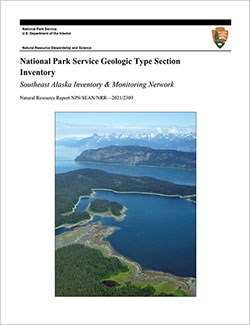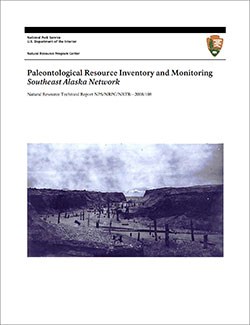
NPS photo.
Geology and Stratigraphy of the Southeast Alaska I&M Network Parks
The Southeast Alaska Inventory & Monitoring Network (SEAN) consists of three national park units in coastal southeastern Alaska that include Glacier Bay National Park and Preserve (GLBA), Klondike Gold Rush National Historical Park (KLGO), and Sitka National Historical Park (SITK). The parks that comprise the Southeast Alaska Network vary in size from 45.7 ha (113 acres; SITK) to nearly 1.12 million ha (2.77 million acres; GLBA).
It is important to note that Wrangell-St. Elias National Park and Preserve (WRST) belongs to both SEAN and the Central Alaska Inventory & Monitoring Network (CAKN). SEAN monitors about 193 km (120 mi) of WRST coastline and the outer coast of Glacier Bay. It is difficult for the CAKN to address park vital signs south of the Bagley ice field and there is an ecological contrast to the rest of the network, making this part of WRST a better fit with SEAN. For further information on WRST, please see the CAKN geologic type section inventory report.
Southeast Alaska consists of a narrow stretch of coastline and offshore islands between British Columbia and the Pacific Ocean. Thousands of islands south of Glacier Bay are known as the Alexander Archipelago. Most of southeast Alaska consists of steep, rocky terrain, with a landscape dominated by glacial activity. The coastline and islands are dominated by fjords.
Southeast Alaska is part of the extensive cordillera along the west coast of North America. The northern portion of the cordillera consists of fault-bounded blocks of crustal rock known as terranes. Many of the terranes contain rocks which range from Neoproterozoic to Mesozoic in age, recording 500 million years (or more) of Earth history before accretion to the North American cratonic margin during the last 100–200 million years (see Appendix B for a geologic time scale). The Fairweather Range and the contiguous St. Elias Mountains form the highest mountains along the north Pacific coast. Mount St. Elias is 5,408 m (18,008 ft) and Mount Fairweather is 4,600 m (15,300 ft) in height. Continued northward oblique transpressional translation movement of the Pacific plate relative to North America results in ongoing uplift.
The Coast Mountains are a north–south trending mountain chain on the eastern boundary of Southeast Alaska consisting of metamorphic and plutonic rocks of the Coast Mountains Complex. The metamorphic rocks in the Coast Mountains Complex have been assigned to the Yukon Tanana and Stikine terranes of the Intermontane superterrane. A sequence of less metamorphosed rocks occurs west of the Coast Mountains and is recognized as the Insular superterrane. The Alexander, Wrangellia, Taku, and Chugach terranes are part of the Insular superterrane. Upper Mesozoic rocks of the Gravina–Nutzotin belt were deposited on the Intermontane superterrane after its accretion to North America, and on the Insular superterrane before and during its accretion to North America.
Thick ice sheets have carved the coastal mountains and mountainous islands along the coast since the Miocene. Glaciers continue to shape the rugged terrain of Southeast Alaska and glacier features dominate the landscape. Southeast Alaska is world-renowned for tidewater glaciers and the calving of glacial ice to form icebergs. The many fjords and channels throughout the area are the result of glacial erosion.
A Brief Geologic History
A few examples of events and Network resources in each geologic time period are highlighted below, from youngest to oldest.
Paleocene and Eocene intrusive rocks are mapped at KLGO. At GLBA, Paleocene to Miocene intrusive rocks are mapped north and east of Glacier Bay, and the Oligocene Cenotaph Volcanics and Miocene Topsy Formation are mapped west of Glacier Bay. The Middle Miocene–Early Pliocene Yakataga Formation and the Late Pleistocene Forest Creek Formation are also mapped in western GLBA.
Undifferentiated Late Cretaceous intrusive rocks, which extend into the Paleogene, are mapped in KLGO. Mesozoic-age igneous rocks and associated sedimentary rocks are reported from western GLBA.
The oldest rocks in SEAN parks are Silurian strata exposed in GLBA. These geologic units include the Willoughby Limestone and Tidal Formation. The Pyramid Peak and Rendu Formations span from Late Silurian through Early Devonian in GLBA. The Early–Middle Devonian Black Cap Limestone and the Early Permian Pybus Formation are also present in GLBA. Metamorphic rocks of the Coast Mountains Complex in KLGO have Paleozoic sources (protoliths).
Precambrian rocks are not exposed in the parks of the SEAN network.
Geology & Soils—Southeast Alaska Network Parks
Type Sections—Southeast Alaska Network

The geologic history above is excerpted from a report titled, "National Park Service geologic type section inventory: Southeast Alaska Inventory & Monitoring Network". Type sections are essential reference locations for the geoscientists who study geologic history and paleontology. A summary of the type sections in each park can be found at the links below.
-
Glacier Bay National Park and Preserve, Alaska (contains seven identified stratotypes)
-
Klondike Gold Rush National Historical Park, Alaska (no designated stratotypes identified)
-
Sitka National Historical Park, Alaska (no designated stratotypes identified)
The full Network report is available in digital format from:
Please cite this publication as:
-
Henderson T, Santucci VL, Connors T, Tweet JS. 2021. National Park Service geologic type section inventory: Southeast Alaska Inventory & Monitoring Network. Natural Resource Report. NPS/SEAN/NRR—2021/2309. National Park Service. Fort Collins, Colorado.
NPS Stratotype Inventory
Fossil Resources—Southeast Alaska Network

Between 2002 and 2011, network-based paleontological resource inventories were completed for all the 32 I&M networks, and six of the earliest were completely updated between 2012 and 2016. The report linked below summarizes the paleontological resources of all park units in the Southeast Alaska Inventory & Monitoring Network (SEAN). The report provides geologic background and paleontological resource data for each park to support management operations, planning, and science-based decision making as required by NPS management policies and the Paleontological Resources Preservation Act (2009).
The full report is available in digital format from
Please cite this publication as:
-
Santucci, V. L. and J. P. Kenworthy. 2008. Paleontological Resource Inventory and Monitoring— Southeast Alaska Network. Natural Resource Technical Report NPS/NRPC/NRTR—2008/108. National Park Service, Fort Collins, Colorado.
Geodiversity Atlas pages—by Inventory & Monitoring Network
Arctic Network Index
Central Alaska Network Index
Chihuahuan Desert Network Index
Cumberland Piedmont Network Index
Eastern Rivers and Mountains Network Index
Great Lakes Network Index
Greater Yellowstone Network Index
Gulf Coast Network Index
Heartland Network Index
Klamath Network Index
Mediterranean Coast Network Index
Mid-Atlantic Network Index
Mojave Desert Network Index
National Capital Network Index
North Coast and Cascades Network Index
Northeast Coastal and Barrier Network Index
Northeast Temperate Network Index
Northern Colorado Plateau Network Index
Northern Great Plains Network Index
Pacific Islands Network Index
Rocky Mountain Network Index
San Francisco Bay Area Network Index
Sierra Nevada Network Index
Sonoran Desert Network Index
South Florida/Caribbean Network Index
Southeast Alaska Network Index
Southeast Coast Network Index
Southern Colorado Plateau Network Index
Southern Plains Network Index
Southwest Alaska Network Index
Upper Columbia Basin Network Index
Geodiversity Atlas pages—by State, U.S. Commonwealth, and Territories
Alabama | Alaska | Arizona | Arkansas | California | Colorado | Connecticut | District of Columbia | Delaware | Florida | Georgia | Hawaii | Idaho | Illinois | Indiana | Iowa | Kansas | Kentucky | Louisiana | Maine | Maryland | Massachusetts | Michigan | Minnesota | Mississippi | Missouri | Montana | Nebraska | Nevada | New Hampshire | New Jersey | New Mexico | New York | North Carolina | North Dakota | Ohio | Oklahoma | Oregon | Pennsylvania | Rhode Island | South Carolina | South Dakota | Tennessee | Texas | Utah | Vermont | Virginia | Washington | West Virginia | Wisconsin | Wyoming
U.S. Commonwealth and Territories
Region 2: South Atlantic-Gulf (Includes Puerto Rico and the U.S. Virgin Islands)
Region 3: Great Lakes
Region 4: Mississippi Basin
Region 5: Missouri Basin
Region 6: Arkansas-Rio Grande-Texas-Gulf
Region 7: Upper Colorado Basin
Region 8: Lower Colorado Basin
Region 9: Columbia-Pacific Northwest
Region 10: California-Great Basin
Region 11: Alaska
Region 12: Pacific Islands (American Samoa, Hawaii. Guam, Commonwealth of the Northern Mariana Islands)
Last updated: February 21, 2025
